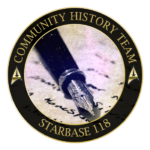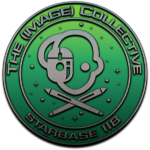

A few months ago, he agreed to answer some questions from our community. We polled our members and put together a list of our “most wanted” questions, which we sent over to him. We’re honored that he agree to answer them, and we’ve compiled the interview into the article below!
Teagan: You’ve been busy with the project re-mastering The Original Series episodes – is there any advice you might give to someone who dares to try re-mastering TNG, DS9, Voyager and Enterprise in 2050? Anything you would hate for them to change? Anything you would love updated?
Michael Okuda: In every case, we’ve tried to respect the primacy of the original artists’ work as much as possible. We also try very hard to meet the expectations of the viewers who are investing their time to watch the program, or their money to buy the disk, or to download the file. These people know the show and they expect to see something that they know and love. It’s important not to betray their trust and expectations. If and when the shows are remastered again, I’m confident that they’ll keep this in mind.
Teagan: With real-world technology advancing so quickly, how do you guys ‘future-proof’ your Star Trek related technologies such as computer user interfaces? For example, the amount of stuff my cell phone can do would make a standard communicator (even a tricorder!) blush. How do you guys deal with this?
Michael Okuda: In a very real sense, you can’t “future proof” the show because you don’t really know where science and technology will go. We’re paid to take an educated guess, and that’s a lot of fun. But one of the most important things is to make your own decisions about the style of our particular fictional future, and try to be faithful to that style, so that the show has a certain internal logic. Matt Jefferies did this brilliantly with his groundbreaking design for the original Enterprise bridge and its control panels. Even when real technology greatly surpassed Matt’s original bridge, it still holds up because it’s internally consistent. In that sense, he did effectively “future proof “ it to a certain extent.
Teagan: Given that current computer technologies in the area of neural interfaces are apparently in the works would it be conceivable to imagine software systems in Trek that featured this? For example, a holodeck in which users could create scene elements with their thoughts? Also, what about brain-assisted user interface configurations? Often, times when using computers it is easy to mistakenly click on one thing when you really meant another. Perhaps in the Star Trek world some kind of neural interface could be developed that could detect the discrepancy between what is meant and what is pressed and activate the functionality corresponding to what is meant accordingly.
Michael Okuda: Neural interfaces are a cool concept, and they may even become real someday, but they could tend to make it difficult to tell Star Trek-style stories. Star Trek’s directors and actors use control panels to help tell the story. Even without dialog, you can tell a lot about the condition of the ship by the way the actors operate their control panels. If neural interfaces were used, it would probably be necessary to find some other way to provide the actors with “business” to help convey the tension in scenes. Not impossible, but more difficult.
Teagan: Also, in the same vein, if it were the case that such neural interfaces could be developed in the world of Star Trek, what would be the implications of research into telepathic species like Betazoids? According to the TNG episode “Night Terrors,” there is no known technology capable of shielding against telepathy. Therefore it would seem that telepathic powers in Trek are based on something other than just EM radiation projected from the brain.
Michael Okuda: Good point.
Teagan: I’m sure you and Denise have several pieces of Trek memorabilia, but I also know you both were heavily involved with putting together the auction for Christy’s. From the pieces sold at auction, were there one or two things you wish you could have kept or bid on for yourself?
Michael Okuda: It’s very different when you work on a television show or movie. Memorabilia is special, not so much for its role in the viewing experience, but because it helps remind you of something that was special in your life. Sure, we’d love to have one of the big Enterprise filming miniatures, but the truth is that we wouldn’t have room in our living room for such a thing. We have memories of having been part of the Star Trek production family. That’s worth far more than any object.
Teagan: As there’s difference between TOS and TNG and later on DS9, ships had been bigger and more compact, in order to face the new threats. However the Romulan main ship in TNG and DS9, the D’Deridex was pretty strange with that “hole” in the middle and let’s not say the compared size. Can you tell us if the design was made just for visual impact or there’s something concrete that was wanted to be shown about the Romulans?
Michael Okuda: You’d have to ask Andy Probert, the brilliant illustrator who created the ship. I do remember him saying that he wanted the ship to be twice as long as the Enterprise-D, so big that the Enterprise could fit in the opening in the middle.
Teagan: When designing new technology or starships, what steps are, or should be, taken to ensure that it is not overpowered?
Michael Okuda: That’s a really important question in science fiction storytelling. The main responsibility for such things falls with the writing department, because you learn most about a ship from the things it does on screen. In the art department, our illustrators and set designers always tried to fulfill the writers’ and directors’ and producers’ vision. For myself (and Rick Sternbach), as tech consultants, sometimes we would make suggestions to that effect to the writers.
Teagan: How do you go about designing a script style/alphabet for a new alien race? Do you use real-world alphabets as a starting point? How much does the description of the race influence your designs? For instance, the Bajoran letters look quite complex whereas Klingon ones are simple and angular.
Michael Okuda: The main thing that I try to do is to give each alien alphabet its own “visual grammar.” No matter how clever your “alphabet” is, if you organize it in groups of two to ten symbols arranged in horizontal rows, it’s going to look like English (or Spanish or Hebrew or French or Russian) when you see it from a distance. Whenever possible, I tried to create a different way to organize and present alien writing.
Teagan: In the Star Trek Encyclopaedia, it once showed four future designs for starships. One is similar to what became the design of Voyager. How was this particular ship design chosen?
Michael Okuda: If you’re talking about the four “Nova” concepts in the Star Trek: TNG Technical Manual, these are things that Rick Sternbach and I came up with. Since Rick designed the Starship Voyager, it’s not surprising that there was some resemblance. Nevertheless, Rick worked very hard to come up with something that he thought looked cool and credible in the Star Trek universe, while satisfying many requirements and suggestions from production designer Richard James as well as our producers. Starship design isn’t easy.
Teagan: I’ve read about your work with the NASA doing the logos of different missions and shuttles. What are your feelings the first time the NASA asked you to work for them? Do you feel that you’re somehow leaving your print in the future or space exploration?
Michael Okuda: Indeed. I’m very proud to have worked with some of the men and women who are working so very hard to explore the real-life frontier of space.
Thank you for the interview Michael, it’s a great honor. Also big thanks goes to questions contributors; Marcus Dickens, Kevin Breeman, Tallis Rhul, Tanjar-Ongra, Alleran Tan, Nathan Baker, Rode Mitchell and Sinda Essen.


















